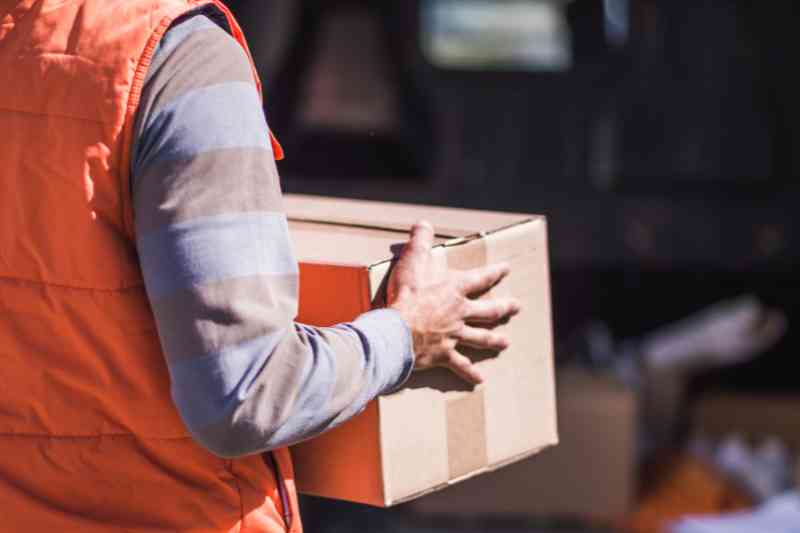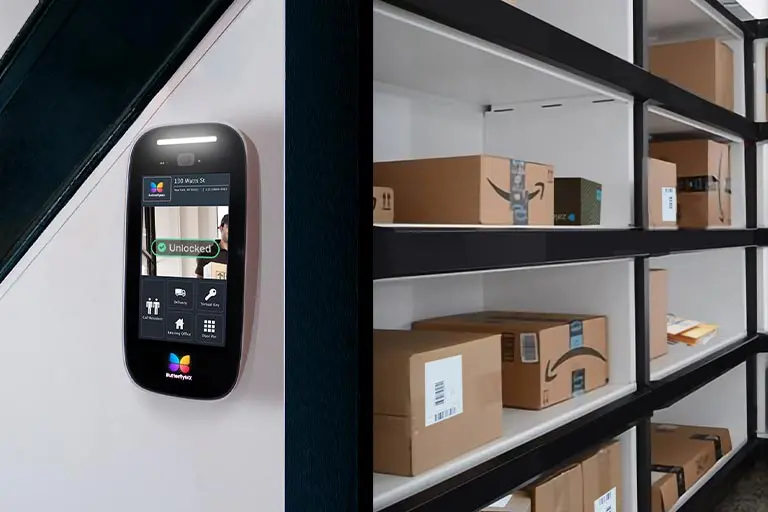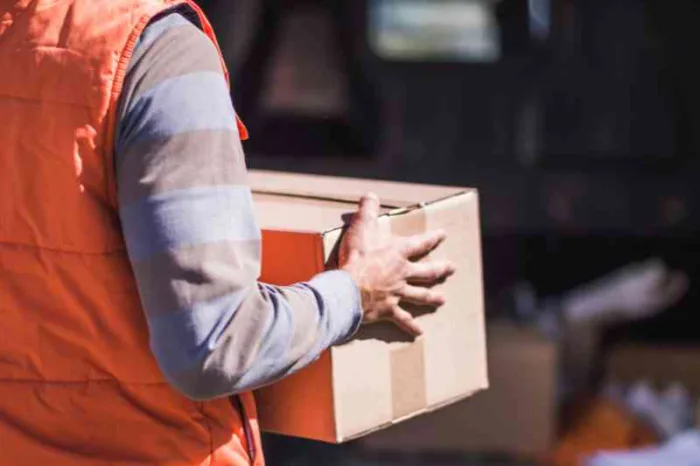Key takeaways
- A delivery door is a secure mailbox receptacle that’s retrofitted into your building’s door or wall.
- A delivery door works as a safe package delivery box where couriers can securely drop off packages.
- Delivery doors are easy to use and tamper-resistant, making them safe and convenient for couriers to deliver packages.
- Delivery doors aren’t great for package management or apartment buildings, and can’t accommodate large packages.
- Four alternatives to delivery doors are package rooms, package lockers, a remote doorman, or an off-site third-party delivery service provider.
- A package room is a smarter alternative because it can accommodate large packages, reduce package theft, and alert residents when their packages are delivered.

Every day, multifamily buildings experience a constant stream of packages delivered. So, property managers and owners are looking for innovative ways to streamline package management. A delivery door is a practical package delivery system designed to make receiving and securing deliveries easy.
Read on to learn what a delivery door is and how it works. Next, delve deeper into the pros and cons of delivery doors. Then, explore four alternatives for package management. Finally, discover the best delivery management solution.
In this post, we cover:
- What is a delivery door?
- How does a delivery door work?
- Pros and cons of delivery doors
- What are alternatives to a delivery door?
- The best package management solution
What is a delivery door?
A delivery door is a secure package delivery box built into a building’s door or wall. For elevated parcel protection, most models are equipped with a keypad lock.
Delivery doors are often retrofitted into the door or wall. As a result, they’re sleek, compact, and convenient for delivery couriers to use.
How does a delivery door work?
Delivery doors work as a secure receptacle for dropping off packages. They’re designed to be a lockable mailbox that protects your packages from the risk of package theft.
Delivery doors work in a few simple steps:
- First, delivery couriers pull up to your building.
- Then, they simply use the keypad to unlock the receptacle that’s retrofitted into your door or wall.
- Finally, they drop the parcels inside. A staff member inside the building can then retrieve the parcels and distribute them to residents.
Learn more about the ButterflyMX package room:
How secure is a delivery door?
Delivery doors are secure because they’re made out of metal, making them difficult to break into. Additionally, they usually come equipped with keypads, so only authorized couriers with an access code can open them.
Pros & cons of delivery doors
Delivery doors may be a practical solution for secure package delivery, but what are their benefits and drawbacks?
Benefits of delivery doors
- Easy to use. Delivery doors are easy for delivery couriers to use and offer a secure location for them to drop off parcels.
- Tamper-resistant. These package drop boxes are constructed from durable materials that are difficult to break into, which reduces the risk of package theft.
- Convenient. Delivery doors keep packages safe until your residents are ready to receive them.
Drawbacks of delivery doors
- Not great for package management. Staff will still have to sort and separate packages since all packages get dropped off in one area.
- Not ideal for multifamily buildings. If you receive a large number of packages daily, it won’t take long to get full. So, they’re not ideal for managing deliveries in apartment buildings. In fact, if your delivery door becomes too full to accept new deliveries, couriers may drop them off in an unsafe area like the lobby or outside the building.
- Can’t accommodate large packages. Delivery doors can’t accommodate large packages like furniture. You’ll have to have a separate package management solution for large parcels.
What are alternatives to a delivery door?
Looking for some alternatives to a delivery door? Let’s assess four other options that help you achieve safe and secure package management
Four alternatives to a delivery door include:
1. Package room
A package room is a designated room in a building that’s exclusively used to store, organize, and manage packages. Package rooms are an ideal multifamily package management solution because they can accommodate any package regardless of size. What’s more, residents can access the mailroom at any time.
Further, package rooms are locked. As a result, only residents and authorized delivery couriers can access the mailroom. This significantly reduces the risk of package theft.

2. Package locker
Package lockers are storage systems with several compartments that delivery couriers use to deliver parcels. Each resident gets a reserved compartment, which eliminates the need for staff to manually organize packages.
However, package lockers have two major drawbacks:
- They aren’t designed to accommodate large packages. Package lockers can’t accommodate any parcel that’s bigger than the dimensions of the individual compartment.
- Some couriers don’t deliver to parcel lockers. Several third-party couriers won’t deliver to package lockers or PO boxes. So, you’ll need a separate solution for the ones that don’t deliver to them.
3. Front desk station
A front desk station uses either an on-site or off-site staff member to manage property access for delivery carriers. The software is installed on a computer with an internet connection, most often at the property’s front desk.
When a delivery driver arrives at the property, the staff at the front desk station can log their entry, manage their access permissions, and even contact the resident to alert them of their package.
While a front door station is great for streamlining access for delivery couriers and managing visitors, it doesn’t keep parcels secure after delivery. Instead, it works best when paired with a package room.
4. Off-site, third-party storage, and delivery
Third-party services like Fetch accept and store packages on the residents’ behalf before delivering their parcels right to their door.
Here’s how these systems work:
- The delivery courier delivers parcels to the third-party service provider’s offsite facility.
- The third-party service will notify the resident once their package has been delivered.
- Your resident schedules a delivery window to receive their package(s).
- The third-party service delivers the package to the resident’s door at the scheduled time.
Although this takes the pressure off your staff for managing deliveries, this option isn’t convenient because residents can’t access packages 24/7. What’s more, your building must have a secure building entry solution like a video intercom to allow secure access for third-party service providers to complete deliveries.
The best package management solution
A package room is the best delivery management solution for multifamily and commercial buildings because it combines the security of controlled access with convenient package management.
The ButterflyMX package room is a robust solution for package management because it eliminates the risk of package theft. And better yet, staff won’t have to spend their time sorting and organizing packages.
What’s more, the ButterflyMX package room takes a time- and- date-stamped photo of the delivery person, resulting in an always-accessible audit trail of entry events. Once the package has been delivered, residents will receive a text notifying them that their package has been delivered, empowering them to grab their parcels at their convenience.







